Australian Visa Processing: Ultimate Guide to Processing Times & What to Expect
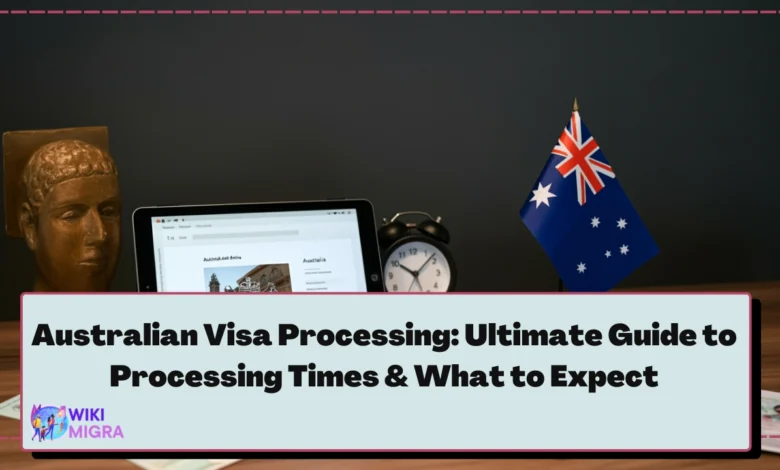
The waiting game that comes after submitting your Australian visa application can be one of the most anxiety-inducing parts of your immigration journey. Whether you’re planning to study, work, join family, or simply visit Australia, understanding Australian visa processing timeframes is crucial for making informed decisions and planning your future effectively.
This comprehensive guide breaks down everything you need to know about visa processing times in Australia, covering official timeframes, influencing factors, practical tips for potentially faster processing, and specific information for popular visa subclasses. However, before diving into details, it’s essential to emphasize that the Department of Home Affairs is the ultimate authority on visa processing times, and their official website should always be your primary reference point.
While this guide provides valuable context and explanations to help you understand how long an Australian visa takes, remember that processing times are indicative and can vary based on numerous factors. The information presented here will help you navigate the process with realistic expectations and proper preparation.
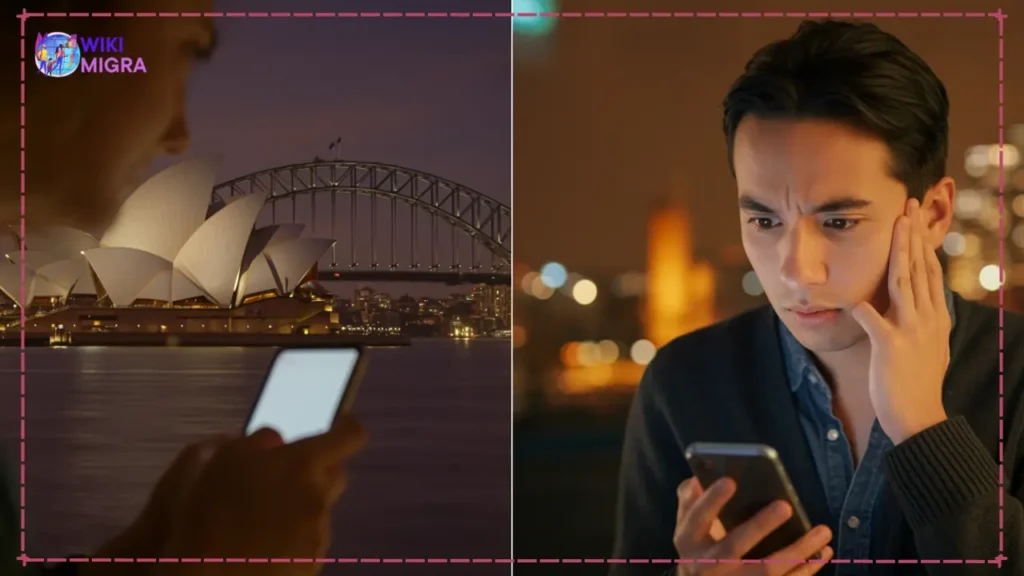
Where to Find Official Processing Times (The Source of Truth)
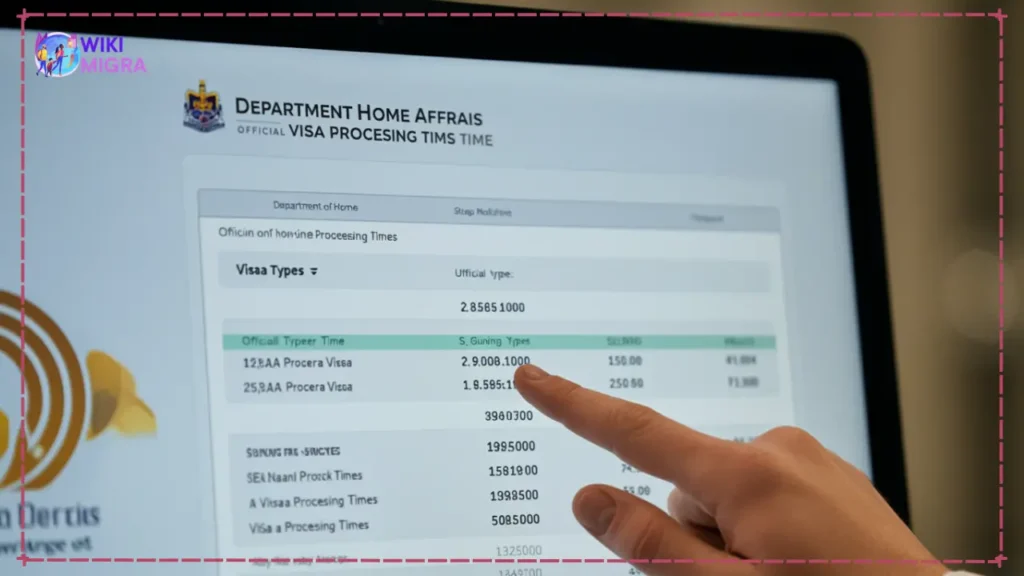
When it comes to checking visa processing time Australia, there’s only one definitive source: the Department of Home Affairs’ official processing times tool.
How to Access the Official Processing Times Tool
- Visit the Department of Home Affairs Global Visa Processing Times page
- Select your visa subclass from the dropdown menu
- The system will display the current processing timeframes for that specific visa type
This tool is the most up-to-date and authoritative source of information regarding Australian visa processing times. The Department updates these timeframes monthly, reflecting the most recent processing trends and operational realities.
Why the Official Tool is the Definitive Source
The processing times provided by Home Affairs are based on actual application data and current operational capacity. No third-party website, migration agent, or forum can provide more accurate information than the Department itself. While anecdotal experiences shared online may be interesting, they don’t reflect the complete picture and shouldn’t be your primary reference.
Understanding Average Processing Times
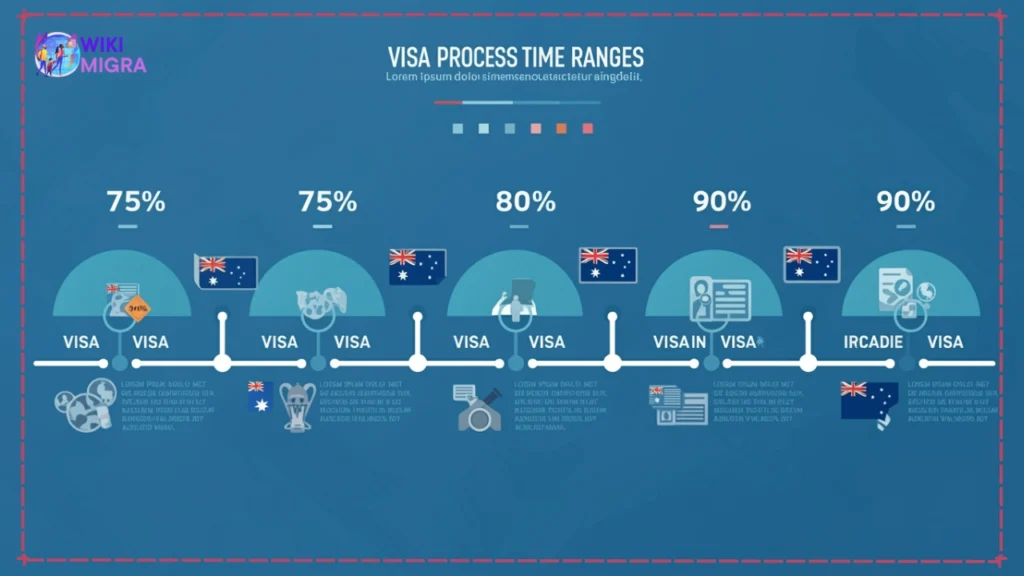
What Do ‘Average Processing Times’ Really Mean?
When you check the official visa processing times Australia tool, you’ll notice that times are typically presented as ranges with two percentages: 75% and 90%. For example, you might see that 75% of applications are processed in 12 months and 90% in 18 months.
These figures represent the time taken to finalize applications in each percentile. In other words:
- 75% of applications are processed within the shorter timeframe
- 90% of applications are processed within the longer timeframe
- 10% of applications may take longer than the stated maximum time
Why Does Home Affairs Provide Ranges, Not Exact Dates?
Processing times are deliberately presented as ranges rather than exact timeframes because:
- Each application is unique with varying levels of complexity
- The volume of applications fluctuates throughout the year
- Verification requirements differ based on individual circumstances
- External factors (like pandemic-related disruptions) can impact processing capacity
- Priority processing directions may change based on government policies
Understanding that these timeframes are indicative rather than guaranteed helps manage expectations. While many applications are processed within or even before the stated timeframes, preparing for the possibility of longer wait times is prudent.
You may be interested in: Understanding Points System for Australian Immigration 2025
Current Australian Visa Processing Times (Summarized & Categorized)
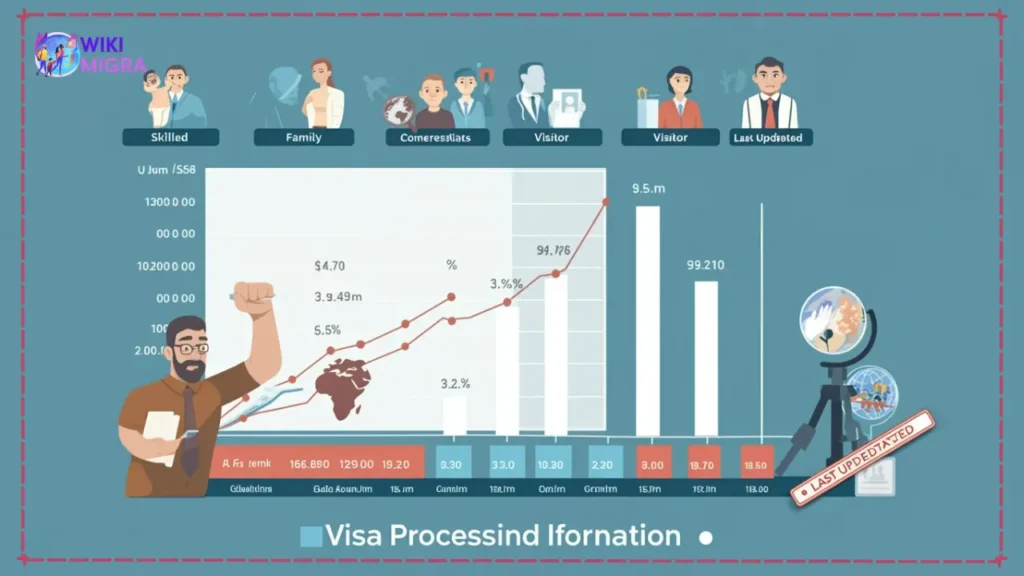
IMPORTANT DISCLAIMER: The processing times summarized below are based on official data from the Department of Home Affairs as of April 2025. These timeframes are subject to change. For the most current and accurate information, always check the official Home Affairs processing times tool.
Skilled Visas
Skilled Independent Visa (Subclass 189)
- 75% of applications: 6-8 months
- 90% of applications: 12-14 months
- 189 processing time can vary significantly based on occupation category and whether you’re in the Points-Tested stream or the New Zealand stream
Skilled Nominated Visa (Subclass 190)
- 75% of applications: 7-9 months
- 90% of applications: 13-15 months
- 190 processing time may be influenced by state/territory nomination processing and priority occupations
Skilled Work Regional (Provisional) Visa (Subclass 491)
- 75% of applications: 6-10 months
- 90% of applications: 12-16 months
- Processing typically depends on regional sponsor response times and regional priority areas
Temporary Skill Shortage Visa (Subclass 482)
- Short-term stream: 75% in 4-6 weeks, 90% in 3-4 months
- Medium-term stream: 75% in 6-8 weeks, 90% in 4-5 months
- Labour Agreement stream: 75% in 9-12 weeks, 90% in 5-6 months
- Skilled visa processing time for this category is generally faster due to its temporary nature and employer sponsorship
Family & Partner Visas
Partner Visa (Subclasses 820/801 – Onshore)
- 75% of applications: 18-22 months
- 90% of applications: 26-30 months
- Partner visa processing time Australia remains one of the longer waiting periods in the family stream
Partner Visa (Subclasses 309/100 – Offshore)
- 75% of applications: 16-20 months
- 90% of applications: 24-28 months
- Slightly faster than onshore partner visas but still represents significant waiting time
Parent Visas (Various Subclasses)
- Standard Parent (103): 75% in 30+ years, 90% in 30+ years
- Contributory Parent (143): 75% in 3-4 years, 90% in 4-5 years
- These represent some of the longest Australian visa processing times in the entire system
Child Visas (Various Subclasses)
- 75% of applications: 7-12 months
- 90% of applications: 14-18 months
- Processing times vary based on the relationship complexity and documentation provided
Student & Graduate Visas
Student Visa (Subclass 500)
- 75% of applications: 4-6 weeks
- 90% of applications: 2-3 months
- Student visa 500 processing time is generally expedited to align with academic enrollment deadlines
Temporary Graduate Visa (Subclass 485)
- Graduate Work stream: 75% in 4-6 months, 90% in 8-10 months
- Post-Study Work stream: 75% in 3-5 months, 90% in 6-8 months
- Processing time depends on assessment of Australian qualification and work experience claims
Visitor Visas
Visitor Visa (Subclass 600)
- Tourist stream: 75% in 2-4 weeks, 90% in 6-8 weeks
- Business Visitor stream: 75% in 3-5 weeks, 90% in 7-9 weeks
- Visitor visa 600 processing time can be shorter for applicants from low-risk countries and longer for high-risk countries
eVisitor (Subclass 651)
- 75% of applications: 1-3 days
- 90% of applications: 5-7 days
- One of the fastest processing visa types, available only to eligible passport holders
Electronic Travel Authority (ETA 601)
- 75% of applications: 1-2 days
- 90% of applications: 3-5 days
- Automated processing results in very quick outcomes for eligible passport holders
Other Common Visa Types
Working Holiday Visa (Subclass 417)
- 75% of applications: 2-4 weeks
- 90% of applications: 4-6 weeks
- Processing is typically expedited to accommodate travel planning needs
Work and Holiday Visa (Subclass 462)
- 75% of applications: 3-5 weeks
- 90% of applications: 5-7 weeks
- Slightly longer than the 417 visa due to additional requirements for some countries
Distinguished Talent Visa (Subclass 858)
- 75% of applications: 3-5 months
- 90% of applications: 6-8 months
- Processing time reflects the detailed assessment of the applicant’s achievement claims
Key Factors That Influence YOUR Visa Processing Time
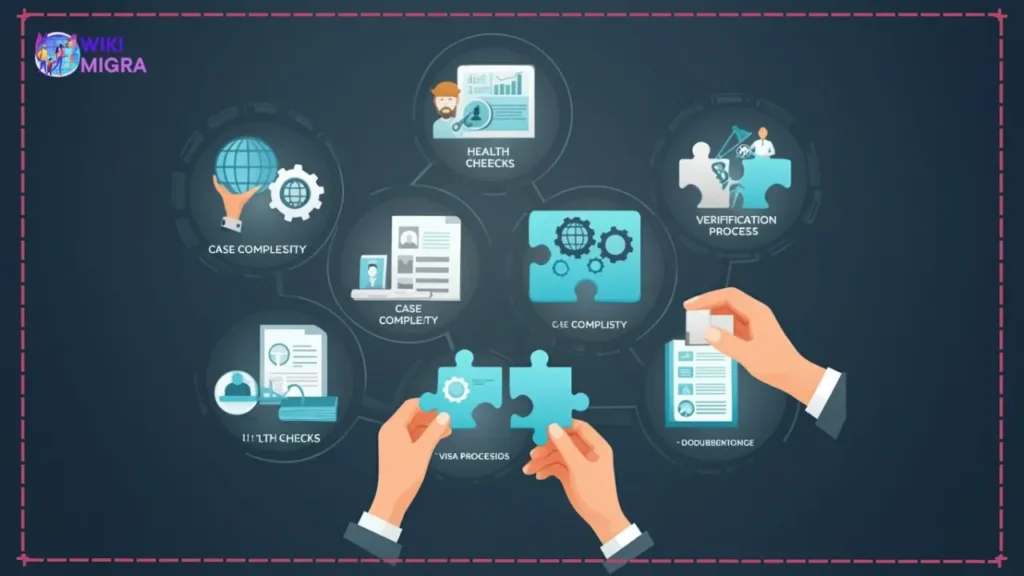
Understanding what affects Australian visa processing times can help you set realistic expectations and potentially avoid unnecessary delays. Here are the critical factors that influence how long your application might take:
How Does Application Completeness Affect Processing Time?
Submitting a complete, accurate, and well-documented application is perhaps the single most important factor within your control. Applications with missing information, inconsistencies, or inadequate supporting evidence require additional assessment time and may trigger requests for further information, significantly extending the processing time.
A “decision-ready” application with all required documentation properly organized and presented can proceed through assessment more efficiently. This doesn’t guarantee faster processing but removes potential obstacles.
What Impact Does Application Volume Have?
The Department of Home Affairs processes millions of visa applications annually, with volume fluctuations throughout the year. During peak periods (such as the start of academic years for student visas or holiday seasons for visitor visas), processing capacity may be stretched, leading to longer wait times.
Similarly, when new visa categories are introduced or when significant policy changes occur, the Department may experience surges in applications that affect processing timeframes across multiple visa categories.
How Does Case Complexity Influence Processing?
No two visa applications are identical. Applications involving unusual circumstances, complex work histories, complicated family situations, or unconventional documentation requirements naturally require more thorough assessment and verification. While straightforward cases might be processed relatively quickly, complex cases often end up in the longer-processing category.
What Role Do Character and Health Checks Play?
Many visa applications require health examinations and character assessments, including police clearance certificates from countries where you’ve lived for 12 months or more within the past 10 years. These external checks have their own processing timeframes that are beyond the Department’s control.
Health and character assessments that reveal issues requiring further investigation can significantly extend processing times. For example, if your health examination identifies a medical condition that requires additional specialist reports, or if your character check reveals prior offenses, the Department will need additional time to assess these matters.
How Do Requests for Information (RFIs) Affect Timeframes?
When the Department requires additional information to assess your application, they will issue a Request for Information (RFI) with a specified timeframe for response (typically 28 days). How quickly and thoroughly you respond directly impacts your overall processing time.
Each RFI potentially adds weeks or even months to processing, especially if multiple rounds of information requests occur. Some applications may require clarification on multiple aspects, each generating separate information requests.
What Impact Do Third-Party Verification Checks Have?
The Department often verifies information with external organizations, employers, educational institutions, or other government agencies. These third-party checks introduce variables beyond both the applicant’s and the Department’s control.
For example, employment verification might be delayed if your former employer is slow to respond or no longer exists. Educational qualification verification might take longer for institutions with limited administrative capacity or during holiday periods.
How Does Application Location (Onshore vs. Offshore) Matter?
Whether you apply from within Australia (onshore) or outside Australia (offshore) can affect processing times for certain visa subclasses. Some visa categories have different processing priorities or separate processing queues for onshore and offshore applicants.
For example, partner visa applications lodged onshore sometimes have different processing timeframes than those lodged offshore. During periods of travel restrictions (such as during the COVID-19 pandemic), onshore applications may receive priority over offshore applications for certain visa categories.
What Role Do Annual Migration Program Quotas Play?
The Australian Government sets annual migration program planning levels, determining how many places are available for different visa categories each fiscal year. When a particular visa category approaches its annual cap, processing for lower-priority applications in that category may slow down until the next program year begins.
This particularly affects family visas, certain skilled visas, and parent visas, which have strictly managed quotas. The implementation of “cap and queue” procedures for certain oversubscribed visa categories (like Parent visas) creates very long waiting periods for those at the end of the queue.
Practical Tips: Can You Speed Up Your Application?
While there’s no magic formula to guarantee faster Australian visa processing, these practical steps can help avoid unnecessary delays:
Submitting a “Decision-Ready” Application
Ensure your application includes all required forms, supporting documentation, and evidence from the outset. Cross-check against the Department’s document checklist for your specific visa subclass. Consider organizing your documents with a clear table of contents and logical naming convention that makes it easy for case officers to navigate your application.
Preparing Documents in Advance
Start gathering required documentation well before you intend to apply. Some documents, such as police clearance certificates, skills assessments, or IELTS test results, have their own processing times and validity periods. Having these ready before submission prevents delays in completing your application.
Responding Promptly and Fully to RFIs
When the Department requests additional information, provide a complete response as quickly as possible. Partial responses often lead to further RFIs. If you need more time to gather requested information, communicate this proactively and request an extension rather than providing an incomplete response.
Ensuring Correct Fees are Paid
Processing doesn’t typically begin until the correct visa application charge is received. Double-check fee amounts before payment, as these change regularly. Incorrect payments cause delays while refunds and correct payments are processed.
Using ImmiAccount Effectively
Keep your ImmiAccount details up to date, including contact information and passport details. Check your account and email regularly for communications from the Department. Enable notifications so you don’t miss important updates or requests.
Managing Expectations: Debunking Myths About “Paying for Speed”
Contrary to popular belief, there’s generally no way to “pay extra” for faster processing. While some visa subclasses offer priority processing for an additional fee or under specific circumstances (such as employer-sponsored visas for businesses with Accredited Sponsor status), most visa categories don’t have expedited processing options.
Similarly, using a migration agent doesn’t automatically result in faster processing. While agents can help ensure your application is complete and properly presented, they don’t receive preferential treatment from the Department.
How to Check Your Application Status
Once your visa application is submitted, you’ll naturally want to monitor its progress. Here’s how to effectively check and understand your application status:
Navigating ImmiAccount
- Log in to your ImmiAccount
- Locate your application under “My Applications”
- Check the status indicator and any messages in your inbox
- Review the “Last Updated” date to see when there was last activity
Understanding Common Status Indicators
- Received: Your application has been received but assessment hasn’t begun
- Initial assessment: A case officer has started reviewing your application
- Further assessment: Additional checking or verification is underway
- Finalised: A decision has been made (approved or refused)
It’s important to note that applications can move between “initial assessment” and “further assessment” multiple times as different aspects are reviewed. The status indicator alone doesn’t provide detailed information about exactly what stage of processing your application has reached.
When to Contact the Department
The Department generally discourages status update inquiries unless:
- You’ve received a notification to contact them
- Your application has exceeded the 90th percentile processing time
- You need to withdraw your application
- You have urgent compassionate circumstances (such as serious illness or death in the family)
For most routine status checks, ImmiAccount remains the best source of information.
Is an Australian visa 3 months or 90 days?
An Australian visa, such as the Electronic Travel Authority (ETA) or Visitor Visa (subclass 600), typically allows a stay of up to 3 months per visit. This is equivalent to approximately 90 days, but the exact duration may depend on the specific visa conditions.
How to Get an Australian Visa Fast?
To get an Australian visa quickly, follow these steps:
- Choose the Right Visa Type: Select the appropriate visa based on your purpose of travel (e.g., ETA for short-term tourism/business, Visitor Visa, or eVisitor Visa). The Electronic Travel Authority (ETA) is often the fastest option for eligible passport holders.
- Apply via the Australian ETA App: If eligible for an ETA (subclass 601), apply through the official Australian ETA app available on the Apple App Store or Google Play. Most applications are processed instantly or within a few hours.
- Submit a Complete Application: Ensure all required documents are accurate and complete, including a valid passport, financial proof (if needed), and any supporting documents like travel itineraries or invitation letters. Incomplete applications can cause delays.
- Avoid Multiple Applications: Submitting multiple applications simultaneously can slow down processing times. Submit only one application per person.
- Use Fast-Track Services if Available: For Visitor Visas (subclass 600), you may opt for fast-track processing by paying an additional fee of AUD 1,000 to receive a decision within 48 hours.
- Contact the Global Service Centre if Necessary: If you encounter issues with your application, contact Australia’s Global Service Centre at +61 2 6196 0196 for assistance.
- Avoid Third-Party Scams: Only use official government channels like the Department of Home Affairs website or registered migration agents to avoid delays caused by fraudulent services.
Note: Processing times vary depending on visa type and individual circumstances.
Sources:
Frequently Asked Questions About Australian Visa Processing Times
Why are visa processing times so long right now?
Processing times fluctuate based on application volumes, available resources, and government priorities. Factors that can extend current processing times include:
- Post-pandemic backlogs
- Changes in migration program priorities
- Implementation of new verification procedures
- Staffing and resource allocations within the Department
The Department regularly reviews and adjusts its operations to manage processing times, but some fluctuation is inevitable as they balance various priorities.
Can I contact Home Affairs to expedite my visa?
The Department generally doesn’t expedite applications except in specific circumstances such as:
- Genuine compassionate reasons (serious illness or death in immediate family)
- Cases involving the interests of a child
- Significant benefit to Australia (major investment or critical skills)
- Error or unreasonable delay by the Department
General requests based on employment start dates, travel plans, or personal preferences aren’t typically considered grounds for expedition.
What does ‘further assessment’ mean on ImmiAccount?
“Further assessment” indicates that your application requires additional reviews, verification, or referrals beyond the initial assessment. This could involve:
- Security or character checks
- Verification of documents with external parties
- Assessment against specific visa criteria that require detailed examination
- Consideration by specialized departmental teams
This status doesn’t necessarily indicate a problem but shows that your application is progressing through multiple assessment stages.
Do processing times differ between onshore and offshore applications?
Yes, for some visa subclasses, there are different processing priorities and timeframes for applications lodged within Australia versus those lodged overseas. These differences can reflect:
- Different risk profiles
- Varying verification requirements
- Distinct processing teams and resources
- Government policy priorities
The official processing times tool specifies whether the times apply to onshore applications, offshore applications, or both.
How often do visa processing times change?
The Department of Home Affairs updates published processing times monthly. These updates reflect recent processing performance and can change based on:
- Current application volumes
- Operational capacity
- Government policy directions
- Seasonal factors
For this reason, processing times provided at the time you apply may differ from actual processing times as your application progresses.
What happens if my application takes longer than the stated processing time?
If your application exceeds the 90th percentile processing time (the longer timeframe stated), you may:
- Continue waiting as some applications legitimately take longer due to complexity
- Contact the Department for a status update, noting that your application has exceeded published timeframes
- Lodge an inquiry through your ImmiAccount
However, the Department is not obligated to make a decision within the published timeframes, as these are indicative rather than guaranteed.
Can I travel while my visa is being processed?
This depends on your current visa status:
- If you’re outside Australia, you can generally travel elsewhere while waiting for an Australian visa decision
- If you’re in Australia on a substantive visa and have applied for another visa, you can usually travel if your current visa allows it
- If you’re on a Bridging Visa A, you’ll need to apply for a Bridging Visa B before traveling
- Some visa applications have specific conditions regarding offshore/onshore status at the time of decision
Always confirm travel implications for your specific situation before making arrangements.
Conclusion
Understanding Australian visa processing timeframes is essential for planning your immigration journey effectively. While waiting for visa outcomes can be challenging, being properly informed and prepared can help manage the process more smoothly.
Key takeaways from this guide include:
- Always check the official Department of Home Affairs website for the most current processing times
- Recognize that many factors influence individual processing times
- Submit complete, accurate applications with all supporting documentation
- Respond promptly to any requests for additional information
- Maintain realistic expectations based on published processing times
Remember that patience is an inevitable part of the visa application process. Focus on what you can control: thorough preparation, accurate documentation, and timely responses to departmental communications.
For particularly complex cases or if you’re uncertain about documentation requirements, consulting with a registered migration agent can help ensure your application is decision-ready, potentially avoiding unnecessary delays in the processing of your Australian visa.
This guide was last updated in April 2025. Processing times are subject to change. Always verify current timeframes through the Department of Home Affairs official website.





